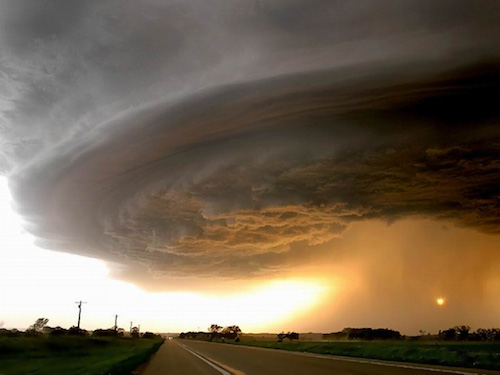
Timing has much to do with the success of a rain dance.
*The Weather*

Timing has much to do with the success of a rain dance.
We tend to take the ability to know what the weather will be like tomorrow, the next day and so on for granted. The more grown-up among us understand that while weather forecasting has reached a marvelous state of refinement, nothing yet developed or likely in the foreseeable future can predict with 100 percent accuracy exactly what it's going to be doing directly over our heads...
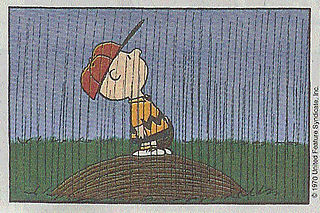
...except in his case.
In some parts of the world, predicting the weather is childishly simple. In Iraq, for example, the weather between late April and mid-September will invariably be cloudless and dry. Daytime high temperatures will gradually increase to the 130s Fahrenheit by about late May, and that's where things will stay through late August before abating somewhat. A fellow in Iraq on June 25th knows exactly what the weather will be like on the 26th, 27th etc. The only variable is dust storms. These alone are able to mitigate the oppressive heat, but this comes at the cost of the inability to breathe.
In North America, with the possible exception of San Diego, weather is more variable. We know from the Weather Channel how patterns develop, how fronts move and, if we're paying attention, we may have a vague idea how pressure affects the weather. An attentive Weather Channel watcher is as fully informed as it's possible to be as to what it's going to be like the next few days - within the limits of technology of course.
What's more, NOAA Weather radios are cheap and widely available. Current cell phones can pull forecasts and conditions from official sources, and it wouldn't surprise me one bit if they can measure conditions directly themselves.
Many people put great faith in the weather predictions in the Old Farmer's Almanac. Its editor certainly does; then again, he would. I'm a regular purchaser of the Old Farmer's Almanac, but only for the astronomy pages. Its weather forecasts are a bit like Nostradamus' cryptic prophecies -ambiguous enough to be considered "right" most of the time, but practically useless. An article on Penn State's website dissects this ambiguity methodically, if gracelessly. The Almanac's value comes from its charm, its wealth of practical information, and its astronomy pages, but its weather predictions cannot be trusted except in terms so vague as to be of no use.
There are more resources available for knowing what the weather is going to be than at any time in the history of mankind. No American smart enough to know which end of the spoon goes in their mouth has any excuse for being ignorant of their near-term forecast. Perhaps because of this convenience, modern man's ability to predict the weather has atrophied. I suspect fewer than four out of every ten American adults could look at the sky - when the sky is at all indicative - and say with any certainty what the weather is going to do in the next day or so.
We prepare against the day when we will have no such conveniences at our disposal. We depend on weather forecasts now. Why would we have less need to know what the weather is going to do after a massive catastrophe?
A case may be made that it's not worth the trouble of learning about weather. Mankind did well enough, the contrarian may say, for untold millennia without Weather-dot-com.
In fact, he kind of did and he kind of didn't. It is true that Mankind went a long way just thinking the Sun God and the Rain God sorted the matter out to their mutual satisfaction. It's also true that primitive Mankind did not live in harmony with his environment, so much as he died in harmony with it - prey to all the vicissitudes of a bountiful but pitiless Nature.
It is also true that primitive Man was just as clever as his modern counterpart. A person born in Solomon's day had the exact same mental capacity and ingenuity as one born in the 1970s. He was no less observant of his surroundings, and perhaps more so, since he depended on his wits more than we do now. The primitive man may not have known about isobars, the hydrologic cycle, the Coriolis Effect or Jim Cantore, but he knew when it was going to rain. Man is by design a learning animal, and our survival is assured to the degree we perceive and understand the world around us.
Here's a trifling example. Suppose I'm doing housework, sometime in summer after a large-scale catastrophe; suppose further that a part of this housework is laundry. We'll still need to do laundry if we don't want to live like stinky, vermin-infested savages.
Doing laundry by hand is toilsome, and time is valuable. I have two options for drying. It can be put on the line, letting the warm breeze from the Southwest do the work, or it can go on a drying rack indoors and take much longer. I decide to put it out on the line, paying no attention to the beautiful white puffy clouds that have accumulated since early afternoon.
Off I go, busying myself indoors. Without my knowing it, one of those beautiful white puffy clouds has turned into a thunderstorm, and this thunderstorm has not only soaked all my laundry, but blown it off the line into the neighbor's yard, where his dogs do what every dog does to a yard. All my time & effort wasted, and all the water & laundry soap I used - likewise wasted.
Anyone can think of more perilous examples of weather turning our plans to dust (or mud), but inconvenience and frustration will surely be the greater portion of our failures. If we don't like inconvenience and frustration now, what makes us think we'll like it any better after a catastrophe?
In other words, why suffer the consequences of ignorance if we don't have to?!
A full understanding of weather, its monitoring and prediction takes time, study and practice, and this article is long enough already. Many good resources exist to help the amateur. The remainder of this article will be an introduction to observing and measuring weather conditions specific to prediction and immediate practical use, as well as tools and resources to aid the observer.
These are the weather phenomena of interest to preppers:
Other weather phenomena - such as vapor pressure, ground temperature, ionization, "winds aloft" and jet streams, cloud ceilings etc. - are relevant only to specialized groups like pilots or scientists. We're not concerned with those; at least, I'm not. They affect our local weather, but it's far more trouble to measure these things than it's worth. The "bullet list" above is everything the layman needs to know about the weather, and the good news is we're born with the most important equipment to detect and interpret it.
The Most Important Resource
The most important resources at our disposal are our own senses and an observant, inquisitive nature. We can go a long way without ever needing a specialized instrument. If it's humid or arid, we'll know it. If it's hot, cold or someplace in-between, we'll feel it. We'll feel the wind and smell the ozone of approaching rain. We will see the state of the sky, clear or cloudy; and if cloudy, what shape and form the clouds take, whence they come and whither they go. These all point not only to what it is doing right now, but also to what it will do in the near future. They tell us this because we've practiced observing our weather and learning those conditions, peculiar to our region, which tend to indicate other events taking place in the future.
Weather has habits, and we can learn its habits.
Of course, we have to know what we're looking at. For this, a reference book is essential. There are many to choose from and most are relatively inexpensive. Peterson's puts out a small, efficient primer, but the best is put out by the National Audubon Society.
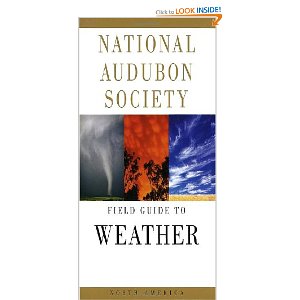
They are of a convenient size, with a sturdy binding for outdoor use and, for the general reader, comprehensive without being dry and scholarly. The Field Guide to Weather has color photos of all sorts of phenomena, but it has a lot more. Its descriptive pages go into detail about what those phenomena are, what formed them, the conditions where they are likely to appear, and what they foretell. The back section discusses observation, and describes all the instruments a weather observer could ever want. This article will give few specific recommendations. This is one of them. Audubon Society Field Guides - not only for the weather but for every other aspect of the physical world - are Worth Every Penny.
So you've got your mind, your senses and your book, and you've started to look around you and get used to how weather happens in your area. Now what?
If you've moved beyond these resources - which cover most of the ground of weather observation and prediction - you should consider what technology will enable you to measure weather conditions, whether for prediction or for use.
If you look in the back of the Field Guide to Weather, you will find descriptions and illustrations of an impressive array of instruments, from the simple to the hopelessly sophisticated. These can accurately quantify any relevant aspect of the weather. Most of these instruments are unnecessary; and the Field Guide, to its credit, tells you so.
Measuring Pressure
If you could only have one instrument for predicting weather - rather than measuring what it is like outside right now - that instrument would be a barometer. It tells the discerning observer more than merely what the weather is doing.
At least half the homes of Americans over the age of 70 have one of these:
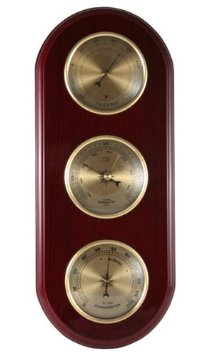
It is a combination thermometer, barometer and hygrometer (for relative humidity). Most are put somewhere for decorative purposes and forgotten. I have one. The thermometer and hygrometer don't tell a thing about the outside. But the barometer works indoors as well as out. It measures air pressure; and allowing for differences in temperature, it's the same inside your home as it is outdoors. We know when the pressure is stable (high or low) the likelihood of rain or snow is less than if it's changing. We also know the rate of its change is related to the severity of a storm.
There are all kinds of barometers. Highly accurate (and fiddly-and-fragile) ones used to be made of glass and brass and filled with mercury. Nowadays they're usually the "aneroid" (airless) type with a needle or a digital display. You can look up how they work yourself. At the other end (in terms of complexity, not necessarily utility) are so-called "storm glasses" or "weather globes." These are vessels of colored water with a very narrow spout at one end:
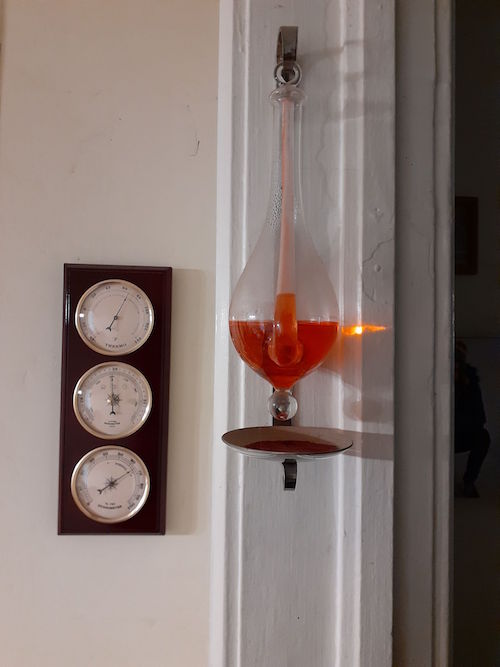
My "station" and Weather Glass
The photo shows the one in my home, along with the indoor "weather station." It's just as useful, as long as you understand its limitations. The water in the glass reacts reliably to changes in barometric pressure. However, the water (and the trapped quantity of air) is also influenced by temperature, which must be allowed for. It doesn't quantify anything but it is a decent indicator of change, something to alert you to consult a more precise instrument - or just look outside.
Aneroid barometers commonly have dials laid off in "inches of mercury" (harking back to the old upright barometers), millibars or both. Some are graduated in kPa or "Kilopascals." If you know what a Kilopascal is, you're an even bigger nerd than I am and you can just stop reading right now. You'll learn nothing new here. Many barometers will have text nearer the center like "Fair," "Change," "Rain," Stormy" and so on. This text is decorative and doesn't mean anything. Let me say that again - the words in the middle of the barometer don't mean anything. The meaningful information from a barometer is whether the pressure is changing or not - whether the needle is moving (and how quickly it's moving), or staying put. Most such instruments have an indicator the owner can move - you put this at the current reading as a place-keeper to tell which way the instrument's hand has moved - and by how much - the next time you look at it.
The instruction sheet or booklet that comes with a barometer will try to convince you your instrument was carefully calibrated at the factory. This is hogwash. Proper calibration takes several days. The ones most of us can afford are set to match, more-or-less, a "master barometer" at the factory, and then packed away for shipping.
And speaking of shipping....
Your barometer was probably made somewhere in Asia. From the factory (where it was "carefully calibrated"), it went down to the port, which by definition is at sea level. Then it traveled on a container ship across the Pacific (and its weather) to somewhere on the West Coast. Unless you live on the West Coast, it then went up the Sierras, down the Sierras; up the Wasatch, down the Wasatch; up the...you get the picture. It then arrives at your doorstep, where the slip of paper in the box tells you it was "carefully calibrated at the factory."
Yeah....
If you're only using the barometer to note its rate-of-change, the actual numbers don't tell you much. In other words, you don't need exact and precise numbers to tell you if a storm is likely. But you may wish to adjust your barometer to agree with what you see on official forecasts, so you can check it and know whether it's working correctly or not. Barometers are adjusted by a small screw at the back. This is where things get dicey and you're liable (especially if the instruction sheet is REALLY informative) to get "wrapped around the axle" on setting the thing up. Here's what you need to know....
Weather reporting in the United States uses "corrected" barometer settings. This means the barometer is "corrected" so it reads what a barometer at sea level would read under the same conditions. There's a very sensible reason for this. Barometric pressure decreases with altitude. There's less air pressing down on the top of Mount Whitney, for example, than there is pressing down upon Death Valley, and the pressure difference between these two extremes of altitude (a difference of around 13.4 inches of mercury) is MUCH larger than what's shown on an ordinary household barometer.
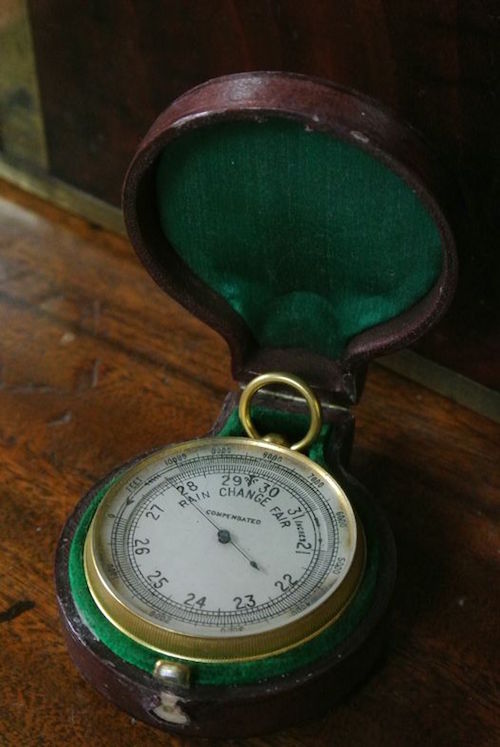
This is what household barometers would have to look like if they weren't "corrected," and most of this range would be wasted.
Weather, on the other hand, changes the pressure by no more than 3 or 4 inches, and usually much less. Having every barometer "corrected" to sea level means everyone can use the same relatively inexpensive instrument, with a smaller-but-more-useful range of values.
"Uncorrected" barometers are almost always used for determining altitude and are therefore almost always found at airports. Airports tend to have both a "corrected" barometer for weather and an "uncorrected" one for pilots to adjust their altimeters - an altimeter is just a barometer with a different dial and different gearwork.
My barometers are adjusted to match the "corrected" instrument at the regional airport. This is the one that shows up when I look at the Weather-dot-gov page for My Fair City. The difference in elevation between the airport and Chez GVI is about 35 feet, but the difference in pressure, small-yet-measurable, is irrelevant. It's more important for my instruments to agree with a meaningful standard than to have them give me accurate elevations - surveyors have other ways of getting accurate elevations.
As you saw in the photo, I own a wall-mounted "weather station," which includes an aneroid barometer like we've been discussing, next to the more archaic "weather glass." I also have a few hand-sized ones. The first barometer I owned, back when I wrote the original version of this article, came from a cheap, plastic wall-mounted "station" I bought at a second-hand store. It was absolutely atrocious and gaudy in appearance; fortunately, the barometer worked and I was able to scavenge it from the ugly frame without damage. Any resourceful and thrifty prepper should be able to find something similar at a resale shop or antique mall. So long as it works, there is no benefit to a more expensive version.
Barometric pressure also relates to our health and well-being, sometimes in strange ways. I used to work with a fellow who got frequent migraines. These were so bad he'd have to go home or not show up to work at all. After a while I noticed it was always raining or snowing on the days he stayed home; and if it rained or snowed heavily the night before, he was unlikely to show up - if he showed up at all - in any shape to work. I brought my observation to him, and after a few similar episodes he himself noticed the trend. He purchased a wristwatch made for backpackers, with a barometer somehow included in its movement. He was able to set it so it would beep an alarm if the pressure started to trend sharply downward, signaling him to take his prescription medication earlier than he'd done normally, long before symptoms occurred or he was aware he needed it. By knowing this, he was able to reduce the effects of the migraines and be well enough to come to work on days that would have laid him up.
The takeaway about barometers is that the important thing they measure is the rate of change of the pressure of the air. When the change is small (there is a small daily back-and-forth change twice every 24 hours) or slow, the weather can be expected to keep doing whatever it's been doing lately. When the change is large and/or rapid, storms are the usual result.
Wind Direction and Speed
In addition to one's own senses, the most useful instrument in connection with wind is a compass. I have a cheap one in my weather kit for determining wind direction. It is only necessary to know the wind direction to within the 8th part of a circle - to the 16th part if you want to be a showoff:
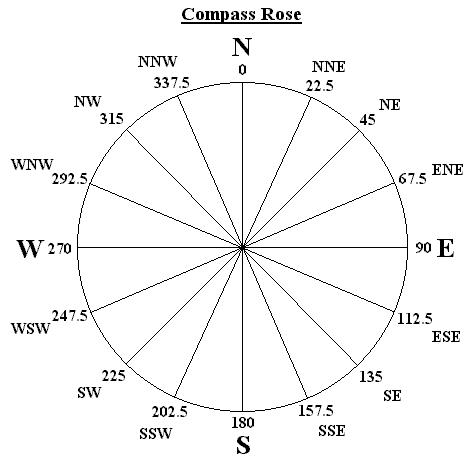
Ask yourself just how far being a weather showoff can possibly get you
It is easy to just guess at wind direction here in Indiana, where most roads and buildings are oriented to the cardinal compass points. Guessing the compass direction of the wind is not as easy "back east" or "out west," where roads look like "webs" more than "networks." Any compass will do, provided it's accurate.
Knowing the wind's direction can help you predict if rain or snow is likely for your area. In my area, a southwesterly wind accompanied by certain other phenomena like I described above predicts a thunderstorm. A northerly wind in winter brings "lake effect" snow from moisture blown off Lake Michigan. Wind from the east means it'll be colder the next day, as it only happens when a low-pressure system moves away and gives rise to wind from the North.
Like barometric pressure, sudden or dramatic changes are the important indicators. Weather vanes are neat, but a flag on an upright flagpole does just as good a job. And unlike a lot of the rest of the world, you never have to go far in the United States to find Our Nation's Colors. They're everywhere.
There are two ways to express wind speed - you can either
Of the two, the latter is more relevant to the prepper. We'll discuss both methods, and explain why a "descriptive" expression of wind speed is best for preparedness.
The instrument for measuring wind speed is called an "anemometer." The most common anemometers measure wind speed by counting the revolutions made by either a vane (the classic kind with the little half-ping-pong-ball cups) or a propeller similar to a computer cooling fan. There are less common kinds that use a "pitot tube" like what's found on an airplane, and the first ones were a u-shaped tube filled with water. I know this because the Smithsonian Institution describes one in their catalogue of weather instruments, but I don't own one, have never seen one in person and only know about them from books. There is also one going by the name of "5-in-1 Weather Station" that uses a sort of hinged paddle on a weather vane.
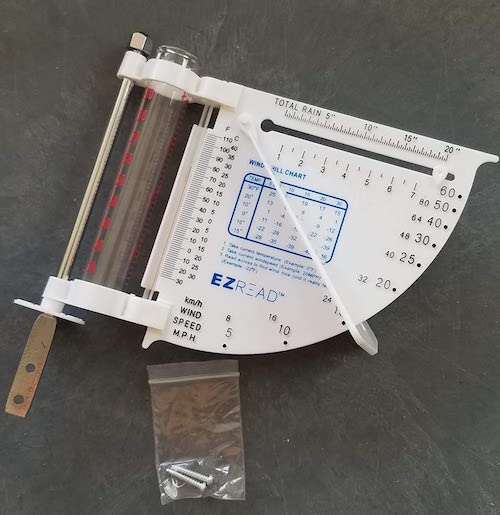
My digital library has an old Russian meteorology text written back when Tsar Nicholas II was still in business, and it discusses an instrument similar to this. Unlike the modern one, the Russian one was meant to be put on top of a building or tower, and was also big enough to read from the ground. The modern plastic one looks simple, compact, clever and affordable; but it's only demonstrational - something Junior-High science teachers might have outside the window of their classrooms. It's too small for a rooftop. You wouldn't be able to see or use any of the device's other functions.
We can all picture the kind with the whirling cups mounted on a pole. Where the option is available, I prefer smaller, hand-held instruments, accepting the limitation that they're only measuring the wind speed near ground-level - I look at the tops of the trees in my neighborhood to see what the wind is doing around 60 feet up, and look at the clouds for what the wind is up to even higher.
Hand-held electronic anemometers are available for not very much money.
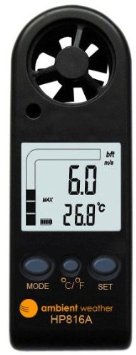
At the time of writing, instruments similar to this are available from Amazon for less than $30.00
They are quite accurate. Back in the 1980s when they were much more expensive, I used one when I worked with the Drop Zone Safety Officer while on jump status. It was important to measure wind speed on the drop zone. Too fast and a training jump was too risky a proposition. In combat, this is less of a consideration but weather is still taken into account.
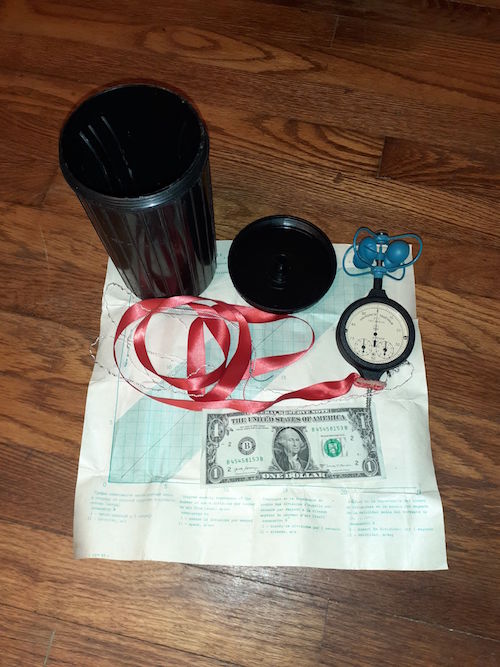
When I have the option, I'll take a non-electric instrument every time
I prepared the ribbon and the cords - the anemometer didn't come with them
The dollar is for scale
I own a wind-driven Soviet clockwork model I recently got from a guy in Ukraine on eBay. It was made in 1990 but the design goes back to the 1800s. It's meant to be screwed to a hand-held pole (I use a painter's pole), and the clockwork engaged/disengaged by pull-strings tied to a switch. I don't recommend it for the prepper. It works and is accurate, but in a way that isn't convenient. The device only counts its own rotations - it doesn't convert these rotations into actual wind-speed. This must be calculated by inputting the duration of the reading, the number of revolutions, a multiplier that accounts for the cups' radius, friction, drag, and so on, and (because AMERICA, dammit!) converted from meters-per-second to miles-per-hour. In other words, it gives you everything you need in order to calculate the wind speed, but you must do the work yourself. It's needlessly complicated for the guy who just wants to know how much of a hurry the air is in. On the other hand, it checks off almost all my nerd sniping boxes:
I also own a simpler and more straightforward instrument:
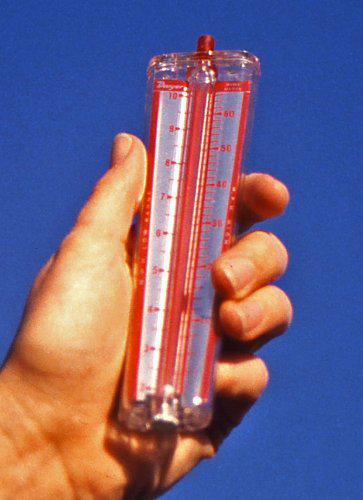
Not as complicated but it doesn't need batteries either, and it's easier to use
You can just make out the tiny ball at the bottom. There is a hole you can't see in the back of the meter. Wind blows into this hole and pushes the ball up. The limit of its rise shows the wind speed against either of two scales on the sides of the instrument. It has a "low range" and a "high range." The instrument is held normally for "low range;" for high range (winds above 10mph), the thumb is held over the little red pipe at the top. It will record winds up to 60mph, which you have no business being in anyway.
I won't go so far as to tell you not to get an instrument like this. But I will say that if I weren't such a nerd about measuring, I wouldn't need them. The truth is that for the ordinary prepper, your own unaided eye will tell you all you need to know. You can simply look at what the wind is doing to things. The good news is there's an easy-to-remember aid to efficiently report the evidence of your senses.
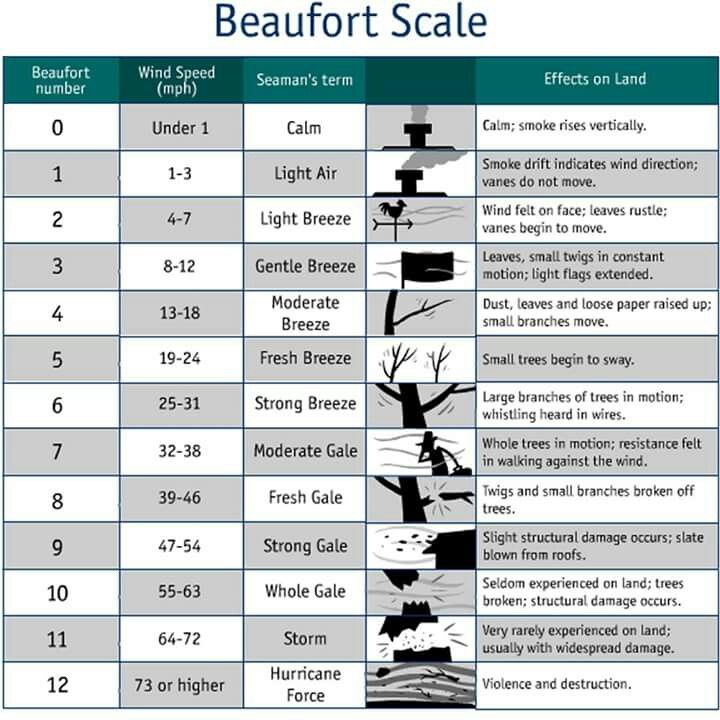
Wind speed really doesn't need to get any more technical than this
In 1805 Francis Beaufort developed a simple scale for wind speed, numbered 1 thru 10 (later expanded to 12), based on observed conditions. Miles-per-hour, kilometers-per-hour, meters-per-second and any other such objective measurements are valuable for specialists, but the Beaufort Scale is truly all a prepper needs. That's a recommendation, by the way.
What I just said goes against not only the prepper's tendency to let the gear solve his problems, but also my own nerdish inclination. If I can easily purchase an inexpensive instrument that measures wind to the tenth of a mile an hour (as in the case of the electronic anemometer above), why wouldn't I?! The answer lies in what a friend refers to in a different context as "Meaningless Increments of Precision."
Next chance you get, go outdoors on a windy day and just feel the wind. You'll note it seldom stays at a constant velocity for more than a few seconds; rather, it varies in intensity, often considerably. What does 0.1 mph matter if the wind's speed varies by 5 or 10 mph in the time it takes to read this sentence? If we're doing some specialized work like predicting wildfire spread, calculating the dispersal of chemical weapon releases or toxic-industrial-chemical disasters, or sorting out sailing/flying navigation problems, wind speed expressed in miles or kilometers per hour (or knots or meters-per-second) makes a lot of sense. But if we're not doing that - and if you're reading this, you're not doing that - it makes much more sense to express (and conceptualize) wind in terms of what it's doing TO things. Despite being subjective, the Beaufort Scale is meaningful for preppers.
Measuring Humidity
Relative humidity relates to our comfort and has other important uses, but does not predict weather. The hygrometer available in the "weather station" or in the cigar humidor is "good enough" if all you want is a general idea, but they are not terribly reliable. They can often be as far off from the real value by as much as 10%, more if older. They register the change in length of either a piece of salt-impregnated paper or strands of human or animal hair.
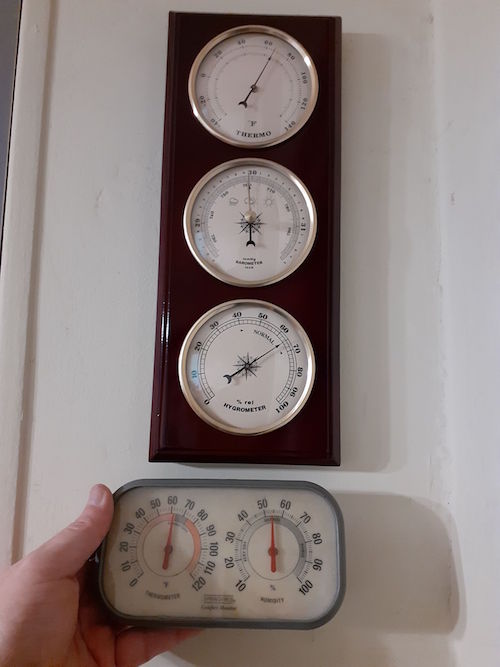
A person with a watch knows what time it is - a person with two watches is never sure
Note the difference between these two readings - a difference of 10% in result, but a difference of over 15% between them. The one I'm holding is much older and used to be outside on my porch. I just took the same reading directly underneath them with the instrument discussed below, and got a value of around 66%. This tells me the wall-mounted one is "close enough," but the one I'm holding in the photo needs to go in the recycle bin - I wouldn't give it to Goodwill because it's inaccurate and I have a conscience to live with. They both tell me it's time to turn on my dehumidifier.
For more reliable data, an instrument called a psychrometer is used.
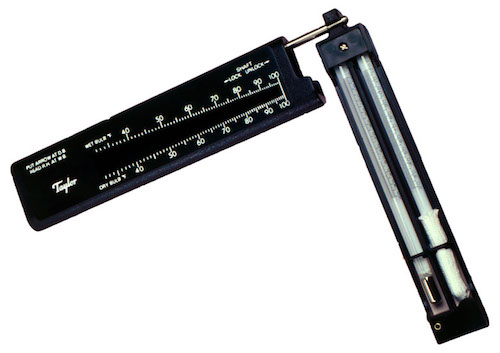
This is one of two I own
Psychrometers measure relative humidity accurately, but indirectly. Look carefully and you will see the portion on the right side of the image is a bracket holding two thermometers, one of which has a cotton wick around the bulb. This is wetted just before use. It is then whirled around, causing the water in the wick to evaporate and, by evaporative cooling, lowering the temperature of the thermometer. The second thermometer experiences no such cooling and merely measures the temperature of the air. Once the mercury in the wetted thermometer stops decreasing, the bracket is unclipped from the little arm and slid into the handle (the part on the left). The two pieces now form a slide rule; and by comparing the dry bulb temperature with that of the wetted one, the relative humidity is read.
My other example is wall-mounted, shown in a photo below. It uses the wind to do the evaporation trick; but if there's no wind, the wick must be fanned to produce the most accurate result. It has no attached slide rule. It came with a slip of paper whose text is the size of the "fine print" in a car lease. Rather than try to use this unreadable slip of paper, I got a booklet put out a long time ago by the forerunner of the National Weather Service. It takes a number of factors into account and can be as precise as the tenth of a percent, but remember what I said about "Meaningless Increments of Precision" above. The simple chart on the slip of paper would have been just fine if it weren't so hard to read. I've included a pdf version of a similar chart that prints out on normal letter-sized paper - you can find it in the appendix.
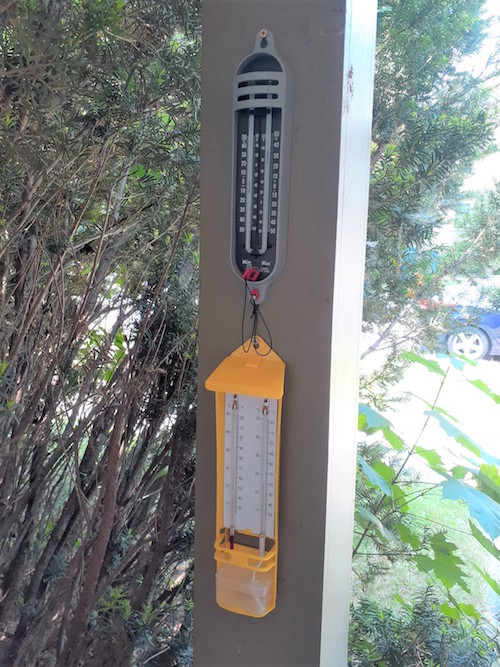
The psychrometer is the yellow thing - we'll talk about the upper instrument in a moment
The setup is not ideal but I'm not about to build a fancy shelter on my small city lot
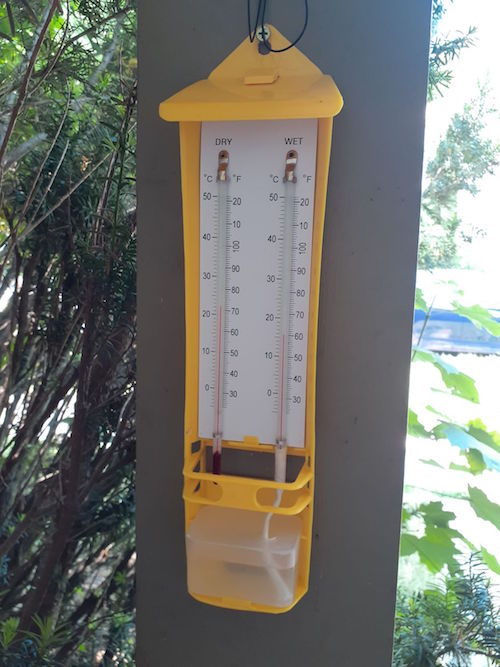
Here's a better photo of the psychrometer - note the wick and "bird waterer" for the thermometer on the right
The wicks need to be replaced from time to time, even if you're using distilled water to wet them. The instrument makers will gladly sell you replacements, but it's better to just use a 4- or 5-inch section of white cotton shoelace. They're cheaper, they work just as well, and you can get them anywhere. Ordinary shoelaces are a tube of cotton just like the special-made wicks, and they slip over the bulbs of the "wet" thermometer just like the special-made wicks. There's no advantage to spending the extra money on the instrument makers' wicks. Cut a section of shoelace cleanly and smartly with good scissors. Chuck Norris may cut the wicks for his psychrometer with a big scary combat knife, but I'm not Chuck Norris, and neither are you. Be a grown-up.
Solar Irradiation
The Armed Forces have known for a long time about the combined role temperature, humidity and the intensity of sunlight ("solar irradiation") have on things like heat exhaustion and heat stroke. They developed a reasonably simple method of taking all this into account; indeed, it's simple enough for Soldiers trained in Field Sanitation to sort the problem out by themselves, and simple enough for Commanders to understand. The Army issues medics and Field Sanitation Teams a kit the size of a pencil box with an array of thermometers in it. It is called the "Wet Bulb Globe Temperature Kit" and it has a fitting to attach to an ordinary camera tripod. The box contains three thermometers: two answering the purpose of a "wet/dry" psychrometer, and one with a tight-fitting tube of copper painted flat black over the bulb. It's set up in the sun and left alone for an hour or so. The three thermometers are then read and their values are entered onto a slide rule attached to the box's lid. The number the slide rule gives you - a function of air temperature, humidity and sunlight intensity - is the "Wet Bulb Globe Temperature," which is then looked up in the table below for the appropriate guidelines.
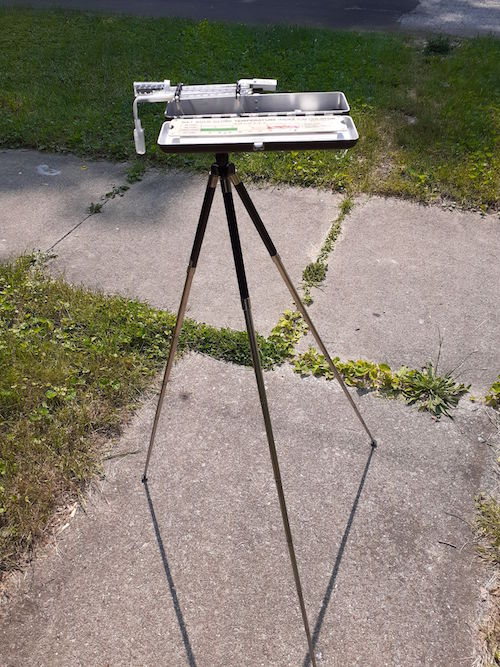
Each of the three thermometers measure a different thing - ambient air temperature, "baked-in-the-sun" temperature and the temperature left after evaporation
Like everything, there are electronic versions available - I know nothing about them except their existence
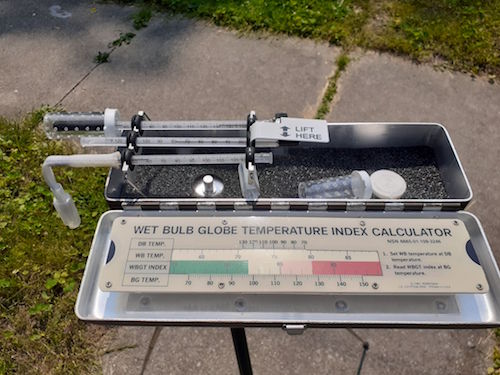
Slide rule - another "nerd-sniping" box checked off
Those of us who were in the military likely remember "Heat-Cat Days" when nothing changed except for the fact we were told to cuff our trousers outside our boots. Leaders were supposed to enforce work/rest schedules, but seldom did. The system built around this kit is supposed to help leaders in the Army (and now other organizations like state highway departments) to make sound decisions relative to work/rest schedules, or how hard people ought to be obliged to work under non-emergency conditions, as well as how long to rest between work periods. A chart discussing these guidelines is shown below:
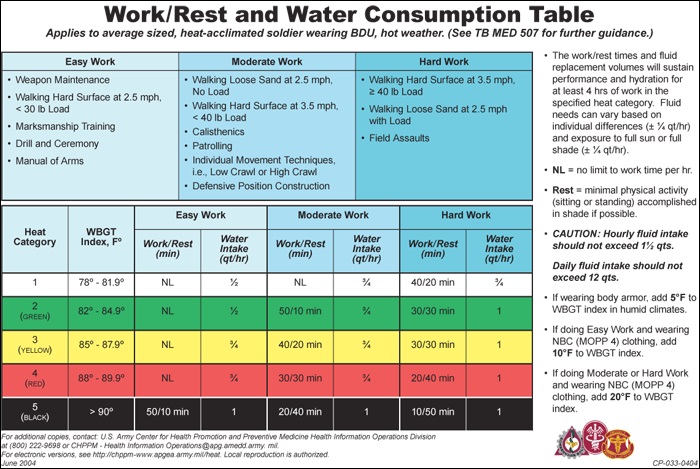
I own the kit in the two photos above; but while it scratches my "measuring-and-slide-rule itch," I don't consider it or anything like it to be a necessary prep item. It doesn't tell us anything we don't already know. We know when we're miserable, and we also know not to work or play ourselves to death, especially if we're not acclimated or if we're wearing bulky or non-breathable protective equipment. We should also be as physically fit as we can.
At least, we should know this. But you and I and everyone reading is acquainted with at least one bullheaded oaf who takes suffering as a point of pride. We could just leave such fools to their Fate if it weren't for their annoying tendency to end up in supervisory positions; and those are the people this Wet-Globe-business was designed to put the brakes on. In other words, if you and the person you work for both have the sense God gave bread mold, you don't need this. Just use your common sense, realize the intensity of sunlight has an effect, don't wait for someone to tell you to drink water, and take breaks BEFORE you start hallucinating or hearing dead ancestors beckoning.
I'm obliged to offer one last word on this kit, and on thermometers generally. When my kit arrived, one of the thermometers - the black-covered one, it turned out - had been "deranged" by its liquid having separated. This sometimes happens when thermometers are shipped and does not always mean the thermometer is ruined. If you have a liquid-in-glass thermometer and this happens to you, the liquid can be reunited, provided it has not completely filled the expansion bulb at the top of the thermometer. If it has done so, there's nothing for it but replacement, because it's impossible to displace the liquid from the expansion chamber. I could not remove the brass tube without destroying it or the thermometer, so I used black shrink tubing on the replacement. This has proved entirely satisfactory.
More information about work/rest cycles and weather factors can be found here.
Dew Point
Dew Point is one of those bits of information people should know more about but don't really. It's the temperature at-and-below which condensation starts to form on surfaces. You see it every time your cold drink has droplets on the outside of the can, glass or bottle. If you wear glasses, you've also seen it in the annoying fog on your glasses when you walk indoors from the dry winter air or, vice-versa, walked out into hot, humid weather from a heavily air-conditioned building. The dew point is a temperature, and it varies based on air temperature, humidity and (to a small degree) barometric pressure. The "psychrometric table" in the appendix tells you the dew point for any given combination of "dry bulb" and "wet bulb" temperature from the psychrometer we discussed above.
It typically relates to comfort - HVAC contractors use it - but it also matters to preppers in at least one way I can think of. I'm sure there are more but I'm only going to list one. If you have optics - binoculars, spotting scopes, night-vision equipment and so on - you want to keep those optics warmer than the dew point or they'll fog up just like your glasses. It's also why you want optics and electronics to approach the ambient temperature (in or outdoors) gradually. Condensation will tend to find its way inside the device and stay there (where it does nothing but harm) unless it's allowed to reach ambient temperature slowly before it's sealed away. This is sometimes a hassle but it saves your instrument from growing fungus inside it (gross) or ruining internal circuitry.
There's an apparatus that measures dew point directly, but it's difficult to use and is more for a school science lab than the Real World. Just look up the dew point in a table.
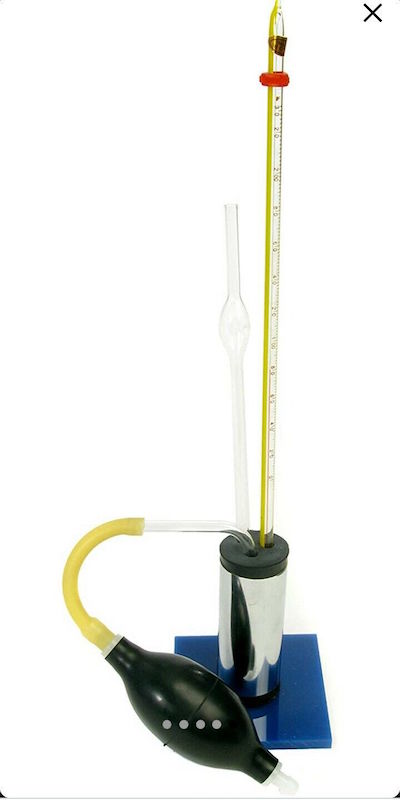
You don't need this
Measuring Rain and Snow
In the original version of this essay, I never took "Jupiter Pluvius" into account. In my defense, the original was about predicting weather, and the only thing rain predicts is whether your kid's birthday party will be indoors. It also hints at some of the areas of preparedness where I have absolutely ZERO aptitude. These include gardening, wildfire management/mitigation, geology, a great deal of soil science etc.
While rainfall isn't predictive, it's worth knowing how much you've got so far. You'll know whether you'll need to use well water on your garden or if you have enough stored rainwater. You'll know - after studying the question a bit - whether it's safe to have a burn pile for your yard waste. You'll know when the ground is saturated or when it's about to be. Combine rainfall with soil analysis and you'll have a better idea of places to build or places to avoid on your property.
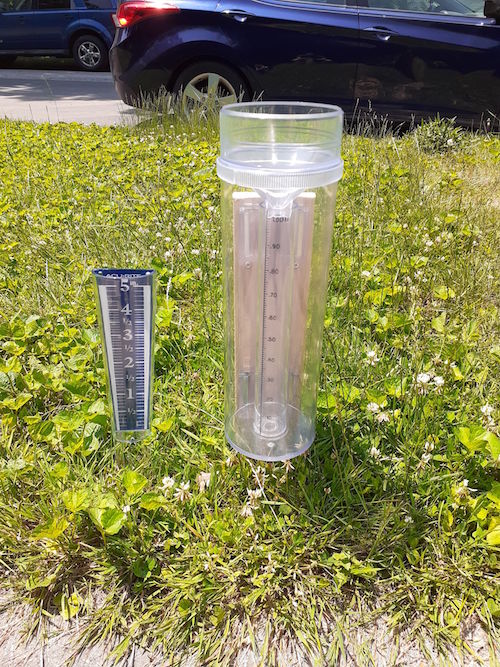
Home and "Away-Game" Rain Gauges
The bigger one is for here at home. Chez GVI is a small city lot with lots of trees around it. There aren't many good places to put a rain gauge. So I screwed its bracket to a pointed piece of wood which gets pounded into the green strip in front of my front door, where I can see it from my porch 20 feet away. The smaller one just goes wherever it's convenient and like the former, need only get stuck in the ground when rain threatens.
There are many styles of rain gauge and while Chez GVI has these two examples, I don't have an opinion on why one might be better than another. Some are more precise than others. Some have a greater capacity than others. Some are more decorative than others. I can't say definitively - they all catch rain. If you think you'll need one, get one, but keep it simple.
The larger rain gauge arrived about a week before the smaller one. When the smaller one arrived, I spent a minute wondering if I'd wasted my money. As you can see in the photo above, the central cylinder of the larger one measures rain precisely to 1/100th inch, in increments of 1.00 inches. But the smaller one measures five times this amount! I compared them by pouring an "inch" from the smaller one into the measuring tube of the larger; and the measuring tube in the larger one only registered 0.22" of water.
Hold on to this number in your mind for a minute - 0.22 - we'll return to it.
Take a look at the photo below - each of the three vessels in the photo contains the exact same volume of water:
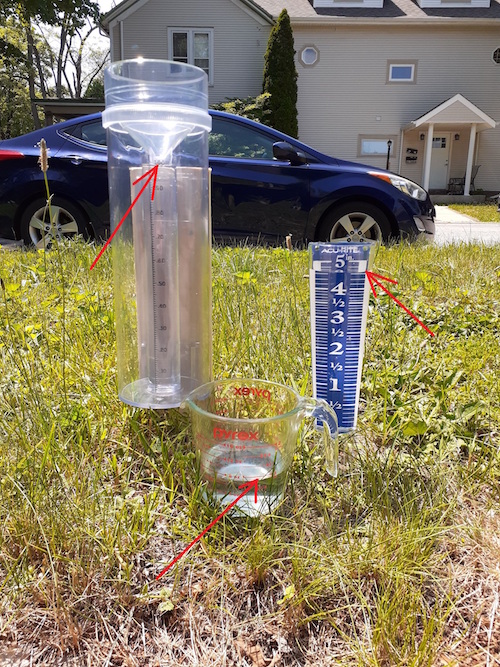
Arrows indicate water level in each
I felt like a sucker for a bit. But remember what I said about being "observant and inquisitive" earlier? I don't like being bewildered. I wanted to know why they were so different. I even wondered if they were wrong at all; and if not, what was I missing?!
As you can see, the larger gauge has a narrow and cylindrical measuring tube, situated underneath a much larger funnel. The smaller one has no funnel but it looks like a tapering half-cylinder. The size of the measuring tube inside the larger one is immaterial - what it's measuring is the rain falling into the funnel, whose area is much larger than the smaller one.
Hmmm....
Out came the calipers. Since I only filled the smaller one to the first inch, I measured its diameter at the bottom. Splitting the difference between the bottom diameter and that at the 1-inch mark came out to around 1.75 inches. The inside of the funnel has a diameter of precisely 4 inches. Easy enough: divide 4 into 1.75.
1.75 / 4 = 0.4375
Then I remembered the smaller one is semi-circular...
0.4375 / 2 = 0.21875
Or near enough to 0.22 (remember?) as makes no difference!
It makes more sense when you remember that a rain gauge is taking a 3-dimensional value (volume) and converting it to a single dimension (height). An inch of rain is an inch of rain, and it's going to be a different volume depending on the size of the collecting area.
If this is hard to wrap your mind around, try this visualization. Suppose it's about to rain. Suppose further that I put these two rain gauges in the middle of a one-acre parking lot, and also go through the ridiculous trouble of figuring out how to capture and measure all the rain that falls in the parking lot itself. Jupiter starts to pluviate, and the parking lot receives an inch's worth of rain. The smaller rain gauge will capture all the rain that falls in the 1.75-inch-diameter-semicircle it covers. The larger one will capture all the rain that falls in the 4-inch-diameter circle the funnel covers. And the parking lot will capture 43,560 square feet (1 acre) worth of rain, to a depth of one inch. The same inch of rain fell on the entire area and the rain gauges will both have the same inch of rain inside 'em, just like the parking lot does. But the small gauge will have around 3 ounces of water, the larger one will have just shy of a cup of water, and the 1-acre parking lot will have 133 gallons, give-or-take.
And it'll all be the same inch of rain.
I went through all this effort for two reasons. First, Facta-non-Verba makes certain demands of us Rubies, especially those of us who write articles we expect others to put their faith in. We have to "show our work." Second, if you buy a rain gauge and it doesn't look like the graduations on it bear any relationship to reality, it has to do with the shape and size of the gauge's opening relative to its depth. In other words - relax, it's probably right.
If you get snow in your area and want to measure it, just get a yardstick from the hardware store. Measure the snowfall before it's settled and compacted. There's a more scientific way to measure snowfall, discussed in the Field Guide. It involves taking careful samples of a given area and melting them to get the snow's equivalent in rain, but it's not worth the trouble. I don't do it. Snow is snow and rain is rain.
Min/Max or "Six's" Thermometer
Like the rain gauge, the "max/min" thermometer is not for telling you what the weather will do, but for telling you what it just did. Like most weather instruments, there are a number of different designs. The classic "maximum/minimum" thermometer was invented by James Six in 1780 and this is the version on the porch at Chez GVI.
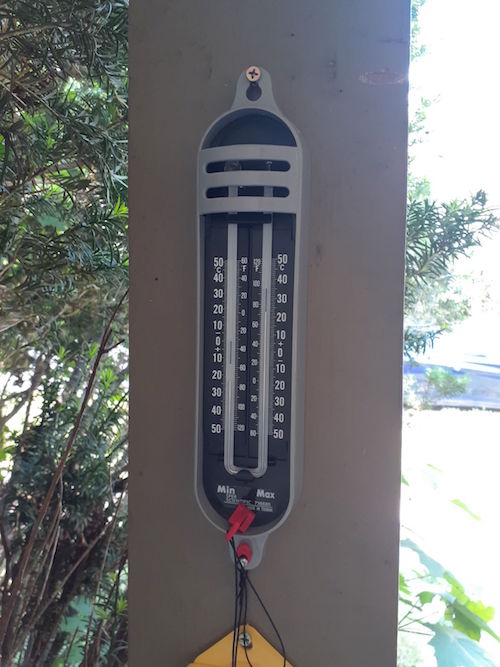
You'll sometimes see it referred to as "Sixe's Thermometer" - English spelling wasn't fully standardized in 1780
It will tell you the high and low temperature for the day, by way of two markers - the little blue things at the top of the mercury columns. The markers get pushed around by the liquid in the thermometer, but stop at the extremes of cold and heat. They're reset with a magnet, which you see on the string at the bottom. The principal advantage of a "min/max" thermometer is it spares you the trouble of constantly monitoring a thermometer all day to see what the high and low were. Even weather nerds have better things to do.
Analyzing Trends
It's difficult to analyze longer-term trends if you don't write things down. It's not entirely necessary to keep a weather log; but if you do, there are plenty of resources. If you decide you want to start regularly recording weather data, take this advice: Start with a pre-arranged form someone else made. I've added a weather-logging form (see appendix) because when you look for "Free Printable Weather Log" most of them are worksheets for children. You can also buy a notebook - there are many different styles and they're not expensive. The Audubon Field Guide suggests a format you can just copy to any notebook you have lying around - I did this with a small surveyor's field book. There are also logging programs but we've confined ourselves to low-tech in this article.
Using someone else's format is a good idea for the following reasons:
I have no recommendations for the format - the one I offer in the appendix is simply one of many. The important thing is that you understand what you're putting in the weather log and why it's there.
When I originally wrote this essay, I had a single small kit that was great for taking out to the field. This was a good thing since I was still in the military and used the stuff on training exercises. I was always a part of the "Headquarters" element, and it's something "Headquarters" tended to want to know. It all fit in a small camera case:
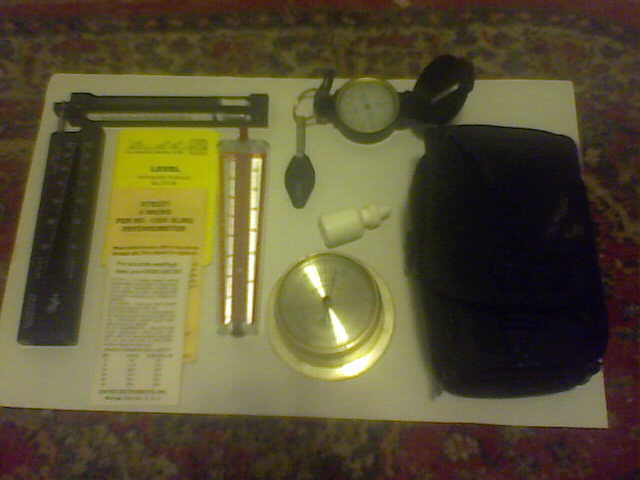
This was my first weather instrument kit
Since then, I've accumulated what amounts to a second set of instruments for home, most of which are in the previous pictures:
The balance of the "new stuff" not yet photographed resides in a cigar box by my front door and gets taken out when I take readings:
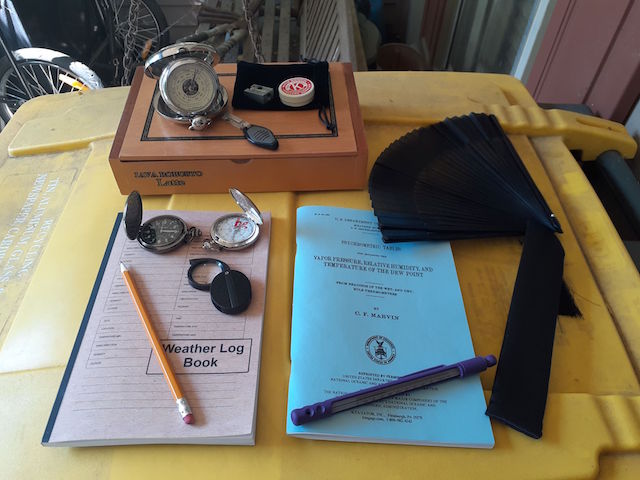
The "field" kit has also expanded and improved somewhat:
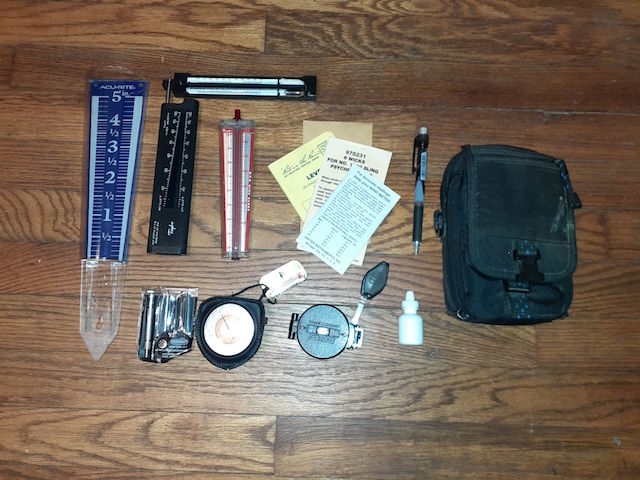
But I don't need all this stuff. What I know and what I can see and feel tells me the most. I'm not the kind of weirdo who'd take weather gadgets on a trip to the zoo.
I tried to limit my recommendations to what's essential from a preparedness perspective, while pointing out things the reader may end up wanting but which aren't necessary. What I have is far more than "essential," but it also points to what someone might want, in addition to what I consider the bare minimum....
Essential:
Expanded:
Nice But Not Critical:
I haven't said a word about "recording" instruments - barographs, hygrographs and the like. These print their results over time (usually a week) on sheets of paper affixed to a rotating drum. Old ones run on clockwork, newer ones plug in. I didn't bring them up because I can't make a preparedness case for them any more than for weather balloons. You have better things to spend your money on.
The same cannot be said of electronic "stations." There are electronic weather stations which give the same results and, it must be admitted, are comparably priced when all my own instruments are added up. But these require electricity, whereas nothing in my kit does. This may or may not be a priority for you, particularly if you're concerned about survivability against an EMP. I'm less concerned with EMP than I am with more humdrum hassles like having a short in some hard-to-access component, needing a hard-to-find replacement part, having to stock up oddball batteries or running out of them, having a component "give up the ghost" the day after its warranty expires, and all the usual annoyances accompanying anything electronic.
There's another reason I avoid electronic instruments, which is partly aesthetic, partly psychological and 100% my-own-hangup. When I look at the display on an electronic weather station, I'm dimly aware of how, for example, the contraption detects temperature, humidity, pressure, windspeed/direction and so forth. But I don't really understand it, and it's not worth my while to figure it out. On the other hand, I can look at a psychrometer and know why the wet bulb gives a lower temperature than the dry bulb. I can look at an anemometer's dial and know why and how it relates to windspeed. I can look at a rain gauge and the reason for its measurement is perfectly obvious. All these things give me a sense of connectedness to the information I'm collecting, and to the environment this information describes. Call it "mindfulness" or "presence" or whatever you like. If I just take a machine at its word, it feels like weather is something that happens to me; whereas when I measure it with "old-school" instruments, I feel as though I have a relationship to and with the weather.
I say all this because I know this preference is unique to me, and the reasons I chose my method may not be reasons you would consider important. And that's fine. You may simply want to know, and know with a minimum of fuss; and for this, an electronic weather station gives you exactly what you want without a lot of fuss. And it will do so at a price point which compares favorably to the array of devices I've accumulated.
This overview brings us back to the valuable resources Nature has already provided us. Time, experience, careful observation and learning allow us to get the most out of the instruments I've described and alluded to.
Most of the articles I write are of little interest to the general public. They concern engineering and mapping topics, Luddite woodworking and craft tools, archaic processes and historical methods. But no less a character than our Savior Himself reminds us that weather happens to everyone: "your Father which is in heaven... maketh His sun to rise on the evil and on the good, and sendeth rain on the just and on the unjust." Not wishing us to be mere passive victims of the weather, God in His wisdom also gives us signs to understand and predict it, and the wit to perceive these signs.
This chart tells you relative humidity and dew point based on wet-bulb and dry-bulb temperatures. It looks complicated but becomes much more understandable after practice.
Psychrometric Chart
If you absolutely can't be bothered to get even the Audubon Field Guide, the National Weather Service has many free resources, and one of the most valuable is their free online and in-person Storm Spotter training courses. The in-person classes happen every year around March and are presented by National Weather Service staff. They tell the student about the most important weather hazards in the area and present valuable "What To Look For" so you know not only what is happening, but what's about to happen and - what I think is equally important - things that are scary- or weird-looking but aren't really dangerous.
www.alpharubicon.com
All materials at this site not otherwise credited are Copyright © 1996 - 2023 Trip Williams. All rights reserved. May be reproduced for personal use only. Use of any material contained herein is subject to stated terms or written permission.